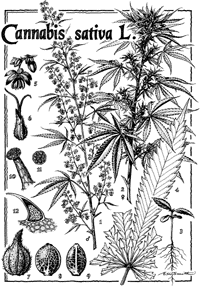Mouse Model Links Alcohol Intake
To Marijuana-like Brain Compounds
Brain molecules similar to the active compound in marijuana help to regulate alcohol consumption, according to new reports by scientists at the National Institute on Alcohol Abuse and Alcoholism (NIAAA), Bethesda, Maryland, and a separate NIAAA-supported group at several New York state research institutions.
In studies conducted with a strain of mice known to have a high preference for alcohol, the scientists found greatly reduced alcohol intake in mice specially bred to lack CB1, the brain receptor for innate marijuana-like substances known as endocannabinoids. The effect was age dependent, the Bethesda group found. The New York scientists showed that the endocannabinoid system activates a brain region known as the nucleus accumbens, which plays a major role in mediating the rewarding effects of alcohol. Both groups had shown that alcohol intake among normal mice of the same alcohol-preferring strain could be reduced by treating the animals with a drug that blocks CB1 receptors in the brain.
The new reports appear in the early online versions of the Proceedings of the National Academy of Sciences, Volume 20, Number 3, at www.pnas.org and the Journal of Neurochemistry, Volume 24, Number 4, in the week beginning January 20, 2003.
"These are important findings," notes NIAAA Director Ting-Kai Li, M.D. "Implicating yet another neurochemical mechanism in alcohol consumption opens another potential avenue for the development of new pharmacologic agents to prevent and treat alcohol problems."
The brain's multiple communication pathways employ a wide variety of signaling molecules known as neurotransmitters to relay messages from one brain cell to another. Researchers have found that alcohol affects numerous neurotransmitters and that a variety of brain pathways are involved in alcohol abuse and dependence. Determining precisely how alcohol interacts with brain cells and affects brain chemistry is an ongoing focus of research. Knowledge gained through this research helps scientists develop drugs to diminish the desire to consume alcohol and to counteract alcohol's effects.
Since their discovery in the early 1990's, endocannabinoids and endocannabinoid receptors have been studied intensely by alcohol and drug abuse researchers. Recent animal studies have suggested that the so-called "endocannabinoid system" is involved in some of the pharmacologic effects of alcohol and in drinking behavior.
In one of the current studies, researchers led by George Kunos, M.D., Ph.D., Scientific Director of NIAAA's Division of Intramural Biological and Clinical Research, found that, among the normal, alcohol-preferring mice - that is, those with intact CB1 receptors - the animals' appetite for both alcohol and food decreased with age. This occurred even though levels of endocannabinoids and the density of CB1 receptors were found to be similar in the brains of young and old mice.
"Although unexpected," says Dr. Kunos, "the observed age-dependent decline in alcohol preference in mice parallels observations in humans, in that only some teenage binge drinkers become alcoholics as adults, and that the onset of alcoholism declines with age."
The researchers found a possible explanation for this phenomenon by comparing the efficiency of the signal sent by the CB1 receptors in different regions of the brain in young and old mice. In old mice, they found diminished CB1 signaling in an area known as the limbic forebrain. The part of the limbic forebrain known as the nucleus accumbens plays a major role in mediating the rewarding properties of alcohol and cannabinoids and also is thought to help regulate appetite. The nucleus accumbens exerts its effects through the release of the neurotransmitter dopamine. Alcohol ingestion typically elicits a robust release of dopamine from the nucleus accumbens.
The second report by NIAAA-supported scientists led by Basalingappa L. Hungund, Ph.D., of the New York State Psychiatric Institute and Nathan S. Kline Institute for Psychiatric Research in Orangeburg, New York, complements the findings of the Kunos research team. Dr. Hungund and colleagues found that, in addition to showing a dramatic reduction in alcohol intake, alcohol-preferring mice that lack CB1 receptors release no dopamine from the nucleus accumbens after they drink alcohol. In mice with intact CB1 receptors, the researchers were able to abolish alcohol-induced release of dopamine from the nucleus accumbens by treating the animals with a drug that blocks CB1 receptors.
"Our results," says coauthor Balapal Basavarajappa, Ph.D., "clearly suggest that the CB1 receptor system is involved in ethanol-induced dopamine release in the nucleus accumbens and indicate that activation of the limbic dopamine system is required for the reinforcing effects of alcohol. They further suggest an interaction between the cannabinoidergic and dopaminergic systems in the reinforcing properties of drugs of abuse, including alcohol."
"Taken together," adds Dr. Kunos, "these findings provide unequivocal evidence for the role of endocannabinoids and CB1 in alcohol drinking behavior in rodents, and suggest that the CB1 receptor may be a promising pharmacotherapy target."
The National Institute on Alcohol Abuse and Alcoholism, a component of the National Institutes of Health, U.S. Department of Health and Human Services, conducts and supports approximately 90 percent of U.S. research on the causes, consequences, prevention, and treatment of alcohol abuse, alcoholism, and alcohol problems. NIAAA disseminates research findings to scientists, practitioners, policy makers, and the general public.
